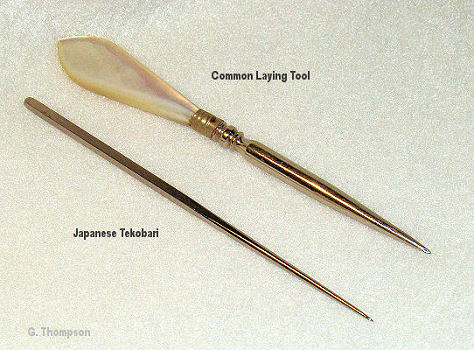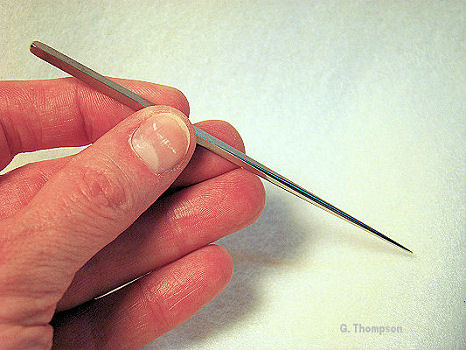Teko-bari: Japanese "Stroking Needle"
Some Western embroidery techniques require or are assisted by a "laying tool" or a "trolley needle" - both are tapered implements used to align or straighten fibers. In traditional Japanese Embroidery, an artist uses a teko-bari. While sometimes called "Japanese laying tools", they actually are quite different. The teko-bari is used for accurate laying of parallel threads in place as they are stitched,
 and
was designed to be used with silk threads without causing damage to
them. Because of this high standard, the teko-bari is one of the better
tools for any fiber, be it silk, cotton, wool, rayon or other
synthetics. As the name implies, the tool is used to "stroke" threads
into place, and this allows for very precise positioning and grooming.
It was also designed to assist in removing stitches; the construction of
the teko-bari is such to aid in removing even the smallest stitches
without disturbing adjacent ones.
and
was designed to be used with silk threads without causing damage to
them. Because of this high standard, the teko-bari is one of the better
tools for any fiber, be it silk, cotton, wool, rayon or other
synthetics. As the name implies, the tool is used to "stroke" threads
into place, and this allows for very precise positioning and grooming.
It was also designed to assist in removing stitches; the construction of
the teko-bari is such to aid in removing even the smallest stitches
without disturbing adjacent ones. A teko-bari and a laying tool are shown in the photo at left; the difference in size is immediately visible, but this is only one of many differences.
A teko-bari is made of soft steel, rather than hard or stainless steel; there is no chrome or protective plating. It is hand-crafted. The soft steel shaft has an extremely fine roughness to it so as to create a very fine, delicate "drag" on the threads; this allows for precise control and easier handling of the thread. A hard-finish tool doesn't allow this, since the threads slide against the tool rather than moving in place. Yet, the teko-bari will not damage even the finest threads - remember, these tools are actually made for working with the finest, highest quality silk fibers.
The shaft of the teko-bari is finer than a laying tool, with a more gradual taper and a sharper point. It also made with a very fine burr (so fine that it's not seen without the aid of a magnifying lens) on the taper, in order to effect that small
 amount of friction
that allows it to "hold" the thread and adjust it. Again, this allows
for more precise and accurate use. When in the hand, it's balanced and
comfortable.
amount of friction
that allows it to "hold" the thread and adjust it. Again, this allows
for more precise and accurate use. When in the hand, it's balanced and
comfortable.If used with flat threads, the teko-bari is placed under the thread loop and stroked in one direction (with the grain of the thread, if there is one) to guide the stitch into place (in Japanese embroidery, no more than three times because of the delicateness of the silks). A wonderful part of the design is that the upper section of the piece of steel it is made from is worked to a square. It is rounded as it proceeds to the point. Due to the squared section of the upper shaft, when it's put down on a flat surface, it doesn't roll away.
A friend was able to locate a teko-bari for me, and it has made a great difference in my work. Although being used in temari rather than Japanese embroidery, it lives up to its description and tradition. It's my most valuable stitching tool, and I never work without it. Those stitchers that have similarly taken on using them all agree that it's the perfect tool to work temari with.
Since teko-bari are made of soft steel, they need to be cared for; it needs to be protected from damage and also from moisture - it will rust (remember, it's not stainless steel or does not have a protective coating). Protect the point and shaft, and don't use it for any purpose other than grooming and guiding threads in your temari work. It should not be stored in an air-tight container, since humidity trapped in the air can cause it to rust. While they are an investment, given proper care, it will last through many generations of temari artists.
Teko-bari can be difficult to locate outside of Japan. There are facsimiles on the Western market being sold as "tekobari" or "tekobari-type" tools; they are generally no different than a slightly altered regular laying tool or trolley needle, even though they may "look" like teko-bari. They are not made of the same steel or constructed with the same methods and standards, and thus don't perform as a true teko-bari does.
This
is a TemariKai.com Printable Page; © 2014, all rights reserved.
Right click to print one copy for personal use.
Last updated 1/2014 © 1998 - 2014 TemariKai.com, G. Thompson/PuffinStuff, Inc.
